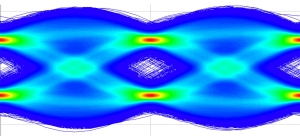Compact optical transmission possibilities are of great interest in faster and more energy-efficient data exchange between electronic chips. One component serving this application is the Mach-Zehnder modulator (MZM) which is able to convert electronic signals into optical signals. Scientists of the KIT and the ETH in Zurich developed a plasmonic MZM of only 12.5 micrometers length which converts digital electrical signals into optical signals at a rate of up to 108 gigabit per second, and presented this device in the “Nature Photonics” scientific journal. (DOI 10.1038/nphoton.2015.127).
“Optical technologies offer an enormous potential especially in transmitting data between computer chips,” explains Manfred Kohl of the KIT. The EU project he directs, NAVOLCHI, Nano Scale Disruptive Silicon-Plasmonic Platform for Chip-to-Chip Interconnection, developed the plasmonic modulator (an electric-to-optical converter) which is the basis of the current MZM. “Compact optical transmitter and receiver units could exceed the speed limits of present-day electronic systems and help get rid of the bottlenecks in data centers.”
The current publication presents an MZM only 12.5 micrometers long, which is roughly one tenth the thickness of a hair. It consists of two arms, each of which contains one electro-optical modulator. Each modulator is made up of a metal-insulator-metal waveguide with a gap approximately 80 nanometers wide and filled with an electro-optical polymer, and sidewalls made of gold which, at the same time, act as electrodes. The electrodes carry a voltage which is modulated in line with the digital data. The electro-optical polymer changes its index of refraction as a function of the voltage. The waveguide and the coupler made of silicon route the two parts of a split light beam to the gaps or from the gaps.
In the respective gap, the light beams of the waveguides initiate electromagnetic surface waves, the so-called surface plasmons. The voltage applied to the polymer modulates the surface waves. Modulation is different in both gaps but coherent, as the same voltage is applied with different polarities. After passing through the gaps, the surface waves initially enter the output optical waveguides as modulated light beams and are then superimposed. The result is a light beam in whose intensity (amplitude), the digital information was encoded.
In the experiment, the MZM works reliably over the entire spectral range of the broad-band optical fiber networks of 1500 – 1600 nanometers at an electric bandwidth of 70 gigahertz with data flows of up to 108 gigabit per second. The large depth of modulation is a consequence of the high manufacturing accuracy in silicon technology. The MZM can also be made by means of the widespread CMOS-processes in microelectronics, and thus can easily be integrated into current chip architectures.
At the present time, some 10 percent of the electricity in Germany is consumed by information and communication technologies, such as computers and smart phones of users, but also by the servers in large computer centers. As data traffic grows exponentially, new approaches are necessary to increase throughput and, at the same time, curb power consumption. Plasmonic components could make a decisive contribution to this end.
The NAVOLCHI EU project serves to use the interaction of light and electrons in metal surfaces to develop novel components for optical data transmission between chips. The project is funded under the 7th Research Framework Programme of the European Union and has a budget of EUR 3.4 million.
For further information about the NAVOLCHI project see: http://www.imt.kit.edu/projects/navolchi
Press release about the electro-optical converter: http://www.kit.edu/kit/pi_2014_14701.php
All-plasmonic Mach-Zehnder modulator enabling optical high-speed communication at the microscale, C. Haffner et al., nature photonics AOP, DOI 10.1038/nphoton.2015.127
www.nature.com/nphoton/index.html
Being “The University in the Helmholtz Association”, KIT creates and imparts knowledge for the society and the environment. It is the objective to make significant contributions to the global challenges in the fields of energy, mobility, and information. For this, about 10,000 employees cooperate in a broad range of disciplines in natural sciences, engineering sciences, economics, and the humanities and social sciences. KIT prepares its 22,800 students for responsible tasks in society, industry, and science by offering research-based study programs. Innovation efforts at KIT build a bridge between important scientific findings and their application for the benefit of society, economic prosperity, and the preservation of our natural basis of life. KIT is one of the German universities of excellence.

